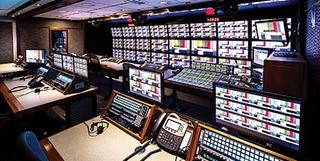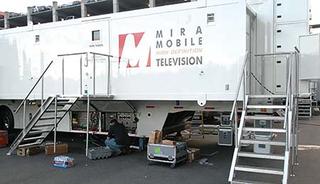Acquisitions, Smart Tech Fuel NEP Success

One of NEP’s newest trucks is the EN1, one of the world’s largest HD production trucks with a series of four different floor plans and several monitor walls for graphics, production and record/replay.PITTSBURGH—We all have our favorites. After 30 years of watching NEP grow from a small OB firm to become a major player in the competitive enclave of production truck manufacturers, you’d think that Mike Werteen would have a favorite among the 70 children in his truck family.
Perhaps the expanding-sided vehicle that can roll out to accommodate 20 personnel? Or the van-sized truck that can squeeze into the tightest of on-location spots? But as president of U.S. mobile units for NEP, Werteen isn’t having any of it.
“Every one of the trucks are valuable to me,” he said, as any proud parent would do, classifying them into fleets that meet different needs—from the largest scale trucks that handle major events like Monday Night Football to small vans for regional events.
30 YEARS
What Werteen and his team can agree on is that the company’s focus on smart technology installations and its series of acquisitions helped it reach a successful 30- year anniversary this year. With locations in the U.S., Australia and the United Kingdom, the company has a fleet of trucks that range from top-tier trucks to smaller-sized vehicle.
“[There are high-end trucks] that have a level of equipment and a level of expertise and a level of cost that is significantly different from the other trucks that handle the biggest shows we have in the industry,” Werteen said. NEP has been on a roll this year in particular, having been involved with some of the biggest events in 2014, from the Oscars to the World Series.

NEP completed its acquisition of MIRA Mobile in September. NEP also has a large complement of smaller-sized vehicles. “There are typically not as many cameras, but they also don’t have as many set-up day [requirements] as the larger shows, he said. The trucks have also proven valuable for baseball and each MLB team’s 162 games a season. “The trucks that work in that class need to be able to be setup and torn down quickly, but they have all the same expectations for a [truck with a] lesser camera count but they have to be able to do it in one day,” he said.
NEP has also branched out from its origins to become a developer of technologies for covering both high-end and smaller venue events, such as a new series of mobile LED display trailers that are being used for the National Hot Rod Association and customized OB flypack solutions.
Get the TV Tech Newsletter
The professional video industry's #1 source for news, trends and product and tech information. Sign up below.
And thus, why there’s no favorites.
BETTER TOGETHER
NEP also attributes its growth to smart acquisitions, a move that NEP has made many times in the last 30 years. Most recently the company acquired the Portland, Ore.-based remote production company MIRA Mobile Television and is in the midst of integrating MIRA’s nine mobile HD units into the NEP fleet.
NEP brought MIRA into its family in part for the company’s regional sports broadcasting experience, its strong West Coast presence, and its experience with large national shows.
“We have a history of growing by acquisition, but we don’t take that step lightly,” Werteen said, pointing as he did several times to the company’s list of fundamental beliefs of taking care of clients, field staff and one another. “It’s a very small community that we are part of,” he said, and the NEP and MIRA team knew each other pretty well. “We knew that we would be better together than apart.”
Part of the company’s growth has been fueled by acquisitions, from Corplex to New Century Productions, and many of those vehicles still have that branding on the side of those trucks. “There are proud legacies in each one of those companies, and we make sure we embrace that,” he said.
For certain, the industry Werteen got into 30 years ago is not the one that exists today.
“The industry and our company have evolved very quickly,” he said, in part due to the enormous role that sports rights has had on broadcast production. NEP has found success primarily because of the company’s focus on staffing and technology for live sports. “[Live sports] remains the most compelling drama,” he said. “It’s become enormous business. And it doesn’t matter if you’re televising the Super Bowl or the World Series or a regional NBA game, they’re all important productions. You need to make sure that the organization understands the importance of that and the responsibility that you have for the viewers that you have watching.”
All this has significantly heightened the amount of concentration NEP has had to place on covering events, and that includes technology. “We need to make sure we’ve aligned the right technology in our mobile units and have made decisions on the components that go into it,” Werteen said. “Will they meet the expectations of the people who are in the front bench of our trucks: the producers and director?”
Those decisions trickle down to the engineers and drivers and staff that are in the field. Being part of a production truck team is a complicated lifestyle, with teams out more than 200 days a year, Werteen said.
One of the biggest recent events for NEP was the World Series. “We had trucks in the Kansas City compound for Fox Sports and the primary domestic feed, and trucks that were taking care of the international feed for MLB, and trucks beside that for ESPN,” he said. “We were very proud because they were all part of the NEP fleet.
“It’s an incredible responsibility we have,” he said, adding that the technology used during the World Series, including high-frame-rate cameras and 4K technology, led to roundly positive reviews of the broadcast coverage of the series.
Looking forward, NEP expects to see growing business from small regional shows as more clients look to do shows on a tighter budget. As a result, NEP is currently building a smaller level of truck. “We are working on trucks that are built from the ground up and will embrace smaller levels of entertainment shows,” he said.
The professional video industry is constantly searching for the right combination when it comes to smart growth. “With more than 5,000 events a year, every one of those events are going to be important to some constituency,” Werteen said. “Even when you successfully pull off Super Bowls and World Series, it shouldn’t undermine the fact that every event for every client is someone’s Super Bowl and World Series.”
Susan Ashworth is the former editor of TV Technology. In addition to her work covering the broadcast television industry, she has served as editor of two housing finance magazines and written about topics as varied as education, radio, chess, music and sports. Outside of her life as a writer, she recently served as president of a local nonprofit organization supporting girls in baseball.

